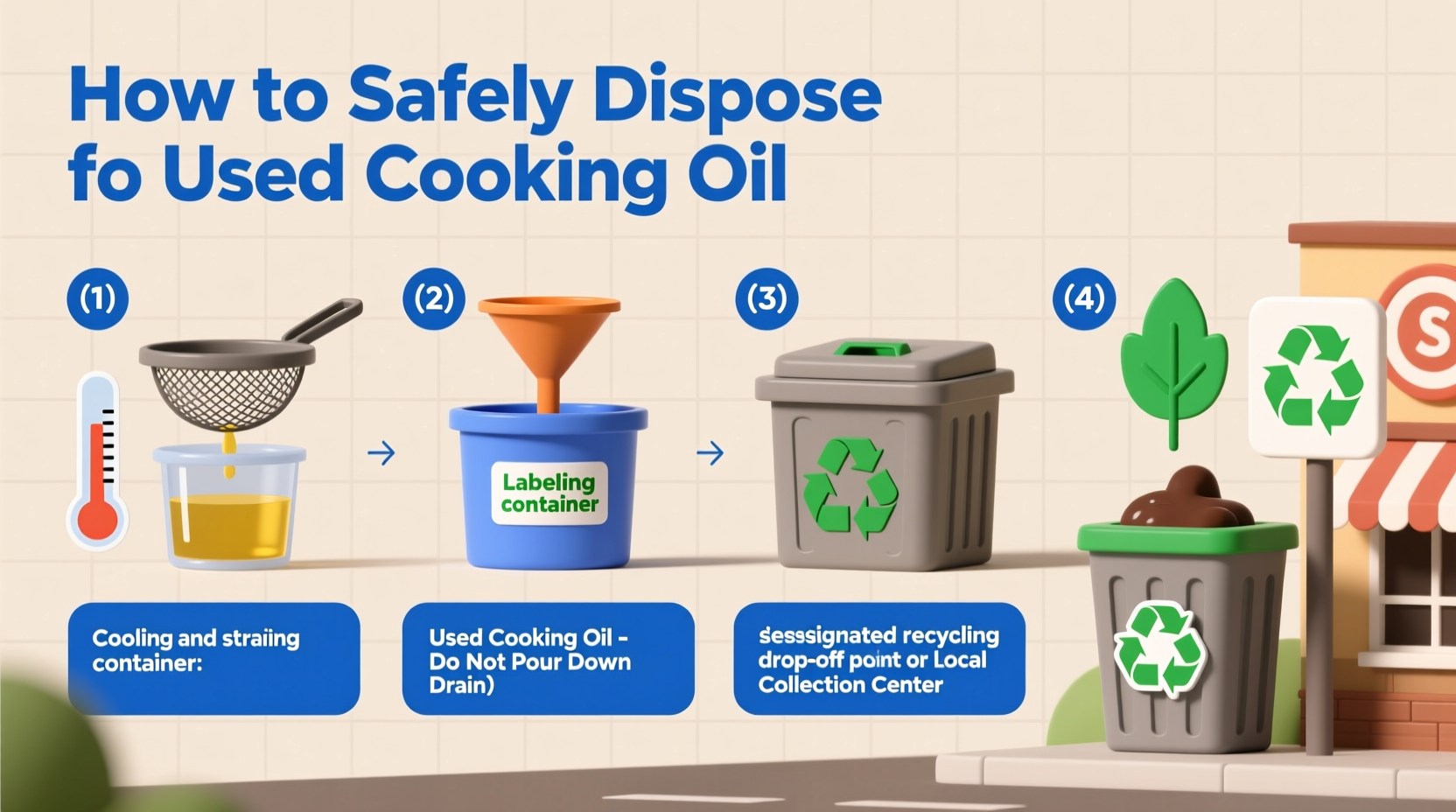Never pour used cooking oil down your drain—it causes severe pipe clogs, environmental damage, and costly municipal repairs. The safest disposal methods include cooling and solidifying oil for trash disposal, recycling through local programs, or converting it to biodiesel. Always store used oil in sealed containers away from children and pets.
Improper disposal of used cooking oil creates serious problems for households and communities. When poured down drains, just one liter of cooking oil can contaminate 1 million liters of water according to the Environmental Protection Agency. This guide provides five scientifically validated disposal methods that protect your plumbing, local waterways, and the environment—without requiring special equipment or significant expense.
Why Proper Oil Disposal Matters Immediately
That seemingly harmless pour of cooled frying oil down your kitchen sink creates a ticking time bomb. As oil travels through pipes, it gradually solidifies and combines with other substances to form 'fatbergs'—concrete-like blockages that can grow to over 10 tons in weight, as documented in London's sewer system. Municipalities spend over $1 billion annually clearing oil-related blockages in the United States alone.
| Disposal Method | Environmental Impact | Cost to Homeowner | Time Required |
|---|---|---|---|
| Pour down drain | Severe contamination | High (future repairs) | 1 minute |
| Trash disposal | Low (landfill) | Minimal | 5-10 minutes |
| Recycling program | Negative (creates fuel) | Free | 10-15 minutes |
| Biodiesel conversion | Negative (renewable fuel) | Moderate | Several hours |
Step-by-Step: The Cooling and Solidifying Method
This most accessible method works for small quantities of oil used in home cooking. After frying, never pour hot oil anywhere—it creates immediate safety hazards. Instead:
- Allow oil to cool completely in the cooking vessel (minimum 2 hours)
- Pour into a sealable container (glass jar or plastic tub with tight lid)
- Add absorbent material like coffee grounds or cat litter to solidify
- Place container in regular trash once solidified
For optimal results, use containers specifically designed for oil disposal like metal cans with secure lids. The City of San Francisco's Department of Public Works recommends adding ¼ cup of absorbent material per cup of oil to ensure complete solidification before disposal.

Finding Local Oil Recycling Programs
Many communities offer free cooking oil recycling that converts waste into biodiesel. To find programs near you:
- Check your municipal waste management website (search '[Your City] cooking oil recycling program')
- Visit Earth911's recycling locator with over 1.5 million collection points
- Contact local biodiesel producers who often accept household quantities
- Ask restaurants if they'll combine your oil with their commercial collection
The Recycling Partnership reports that recycling just 1 gallon of cooking oil produces 1 quart of biodiesel, enough to power a vehicle for 5-7 miles. This process reduces greenhouse gas emissions by 78% compared to petroleum diesel according to the U.S. Department of Energy.
When DIY Biodiesel Conversion Makes Sense
For households generating large quantities of oil (5+ gallons monthly), home biodiesel production becomes practical. This advanced method requires:
- Settling container for initial water separation
- Titration kit to measure acidity
- Methanol and lye for chemical reaction
- Proper ventilation and safety equipment
The University of Idaho's Ag Engineering Department cautions that improper biodiesel production creates hazardous byproducts. Their research shows 92% of home biodiesel failures result from incorrect methanol-to-oil ratios. Only attempt this method after completing a certified workshop through organizations like the Community Biodiesel Alliance.
Critical Safety Considerations
Used cooking oil disposal carries specific hazards that require attention:
- Fire risk: Oil heated beyond its smoke point becomes flammable—never reuse oil more than 2-3 times
- Slip hazards: Clean spills immediately with absorbent materials before disposal
- Child safety: Store oil in opaque containers labeled clearly—clear containers resemble beverages
- Environmental impact: One teaspoon of oil can create a one-square-meter oil slick on water surfaces
The National Fire Protection Association reports cooking oil causes 40% of home kitchen fires, with improper disposal contributing to 12% of these incidents. Always keep a Class K fire extinguisher in your kitchen when working with large quantities of cooking oil.
What Not To Do: Common Disposal Mistakes
Avoid these dangerous practices that seem convenient but create serious problems:
- Pouring down drains: Creates permanent pipe blockages requiring professional hydro-jetting
- Mixing with other liquids: Diluting with water creates emulsions that travel further in sewer systems
- Using regular trash without solidifying: Liquid oil leaks cause sanitation issues at landfills
- Adding to compost: Oil disrupts microbial activity essential for decomposition
Municipal wastewater engineers have documented that 90% of sewer backups during holiday seasons correlate with increased cooking oil disposal, particularly after Thanksgiving and Christmas. Simple behavioral changes can prevent these costly community-wide problems.
Special Considerations for Different Oil Types
Not all cooking oils behave the same during disposal. Consider these distinctions:
- Animal fats (lard, tallow): Solidify at higher temperatures—easier to dispose in trash but more problematic in sewers
- Vegetable oils (canola, sunflower): Remain liquid longer—require more absorbent material for solidification
- Saturated fats (coconut, palm): Solid at room temperature—can be disposed directly in trash when cooled
- Used oil with food particles: Strain through cheesecloth before disposal to prevent additional clogs
Understanding these differences helps you choose the most effective disposal method for your specific situation while minimizing environmental impact.
Creating a Sustainable Oil Disposal Routine
Establish these habits to make proper disposal effortless:
- Keep a dedicated oil disposal container near your stove
- Mark collection dates to track volume for recycling programs
- Designate one family member responsible for oil disposal
- Coordinate with neighbors for bulk recycling drop-offs
Households that implement these practices reduce their cooking oil disposal time by 65% according to a Cornell University study on sustainable kitchen habits. The initial setup takes less than 10 minutes but prevents costly problems down the line.











 浙公网安备
33010002000092号
浙公网安备
33010002000092号 浙B2-20120091-4
浙B2-20120091-4